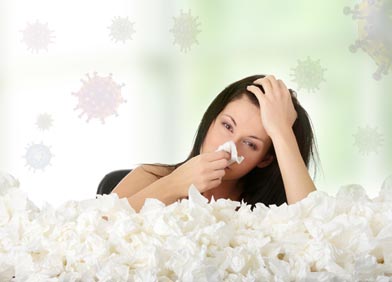5 Steps HVAC Systems Can Ease Allergies
Easing Your Allergies in 5 Easy HVAC System Steps
The trigger for allergies happens when a normally harmless substance is considered by the body as foreign; the body creates antibodies to attack the substance and works to remove it from the body. Five of the ten most common allergies are caused by airborne particles—pollen, dust mites, pet dander, mold, and perfumes/household chemicals. These allergens cause itchy and watery eyes, runny nose, nasal congestion, coughing, and wheezing.
Your HVAC system was designed to help reduce airborne particles, including most of these allergens, from homes and businesses. When you reduce the number of particles, you reduce the allergic response. If you or your family suffer from seasonal allergies, there are a few things you can do to enhance the normal filtration function and remove more allergens. Here are five easy steps to take to remove allergens using your HVAC system.
- Remove Existing Allergens.
- Stop new allergens from getting in by keeping windows and doors closed during allergy season. Weatherproof your doors and windows; it will make your home more energy-efficient, more comfortable, and will reduce drafts that bring in pollen and mold spores.
- Take your shoes off at the door to prevent depositing pollen throughout the house.
- Diligently clean hard and soft surfaces often during allergy season. Airborne particles, including pet dander, get deposited around the house and can be removed with a dust cloth or a vacuum cleaner.
- Upgrade Your Air Filter.
- Every HVAC system will have an air filter, designed to pull dust, dirt, and dander from the circulating air. Generally, air filters are made from paper or fiber with very small holes to let air through, but small enough holes to capture airborne particles.
- Air filters are rated by the size of the opening, with a Minimum Efficiency Reporting Value or MERV rating. Common air filters have a 6 MERV rating, but your HVAC system can handle an air filter with an 11 to 13 MERV rating. If seasonal allergies are a problem, an 11 MERV-rated filter or higher will take out dust and pet hair like other filters, but it will also collect microscopic pollen and mold spores.
- Air filters need to be changed to work efficiently. The collected particles will clog the filter and reduce the air flowing through the entire system. The rule of thumb is to change your air filter every three months, but each home is unique, and you will need to inspect it periodically to see if that is enough. Set a schedule with reminders to change your air filter on time.
- Consider Air Purification Additions.
- Ultraviolet light will neutralize living, organic matter, including pollen, mold, bacteria, and viruses. The lights are installed in the ductwork to kill off these allergens and prevent growth. The air filter picks them up more readily when they are inert.
- Ionization filters use static electricity to attract particles that the air filter might miss.
- Consult with your HVAC professional to explore whole house and portable room air purifier options.
- Keep Allergens Out of Ductwork.
- The powerful HVAC blower motor keeps most dust and airborne particles moving; even particles that might be deposited in ducts will be picked up and circulated during the next cycle.
- The Environmental Protection Agency does not recommend regular duct cleaning, since so little is deposited inside of ducts.
- There are a few reasons to have ducts inspected and cleaned. These reasons include:
- Discovering mold growth. If mold is growing in one area of the house, the spores are being carried through the ducts. As part of the mold mitigation, the ducts will need to be cleaned.
- If mice, rats, squirrels, or other pests have made a home in the ductwork, the mess they make will need to be cleaned as part of the removal process.
-
- If an unusual amount of dust is collecting on surfaces, it may indicate a buildup that needs to be cleaned.
- Mold Will Follow Humidity.
- Mold can grow when organic material, including dust, and moisture is abundant.
- Areas where moisture can accumulate unnoticed include bathrooms, kitchens, laundry areas, basements, and leaky attics. Mold can also grow in areas that have previously experienced flooding.
- Inefficient or failing air conditioners can also lead to moisture and mold growth.
- Moisture accumulation normally requires repair and potential mold mitigation. If moisture continues to be a problem, portable room dehumidifiers are available to remove excess moisture from the air.
Have Questions About Easing Your Allergies in 5 Easy Steps?
Let us know how we can help with reducing allergens with proper HVAC system maintenance, call AllCool AC & Heating at 281-238-9292 or contact us via email.
